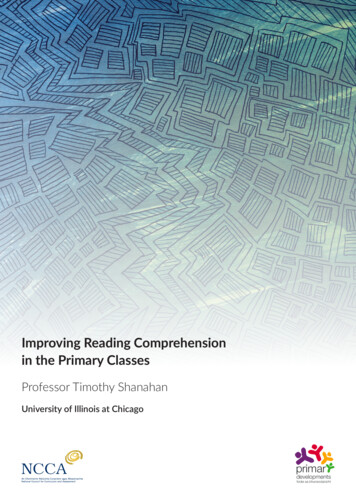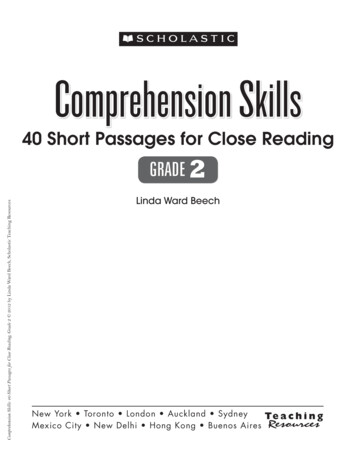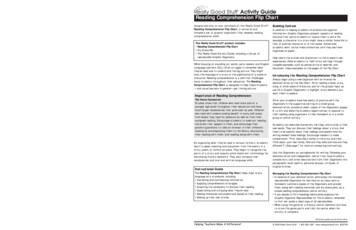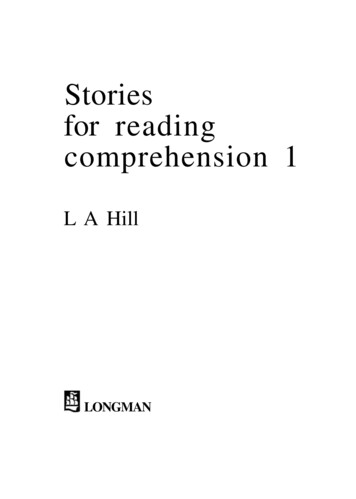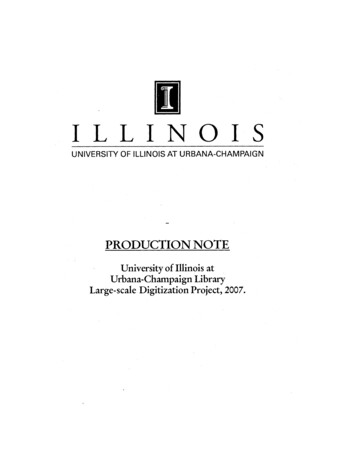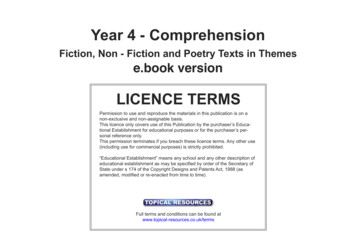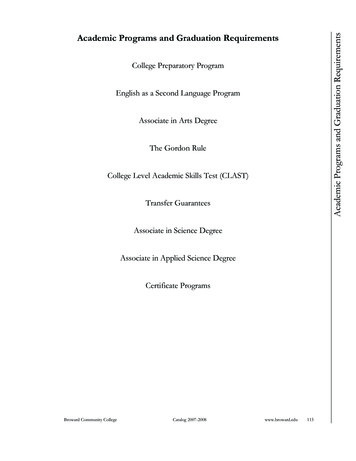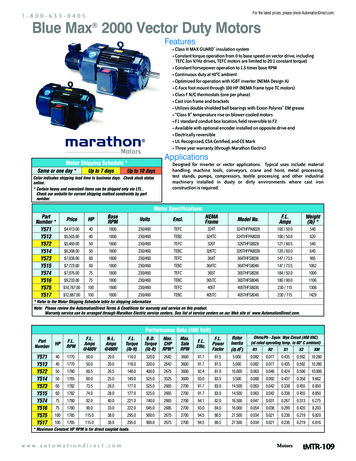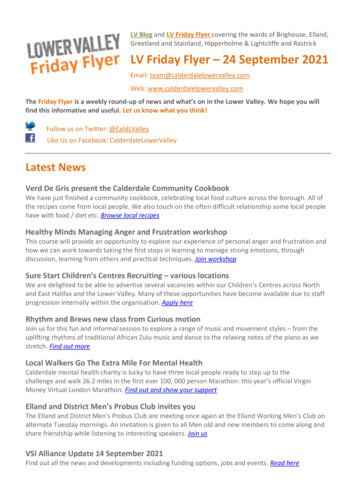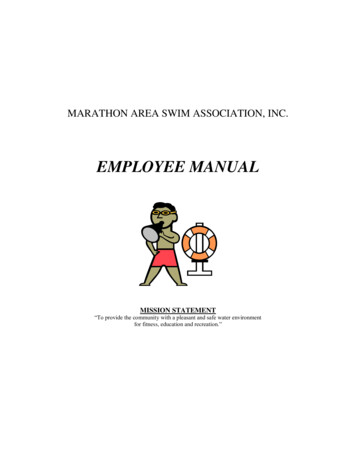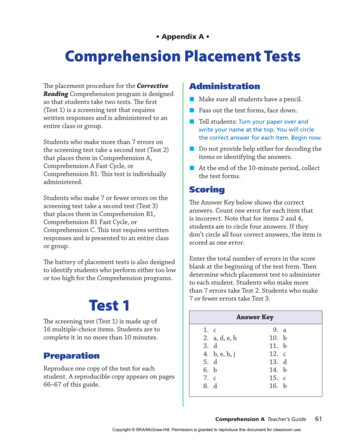
Transcription
Appendix A Comprehension Placement TestsThe placement procedure for the CorrectiveReading Comprehension program is designedso that students take two tests. The first(Test 1) is a screening test that requireswritten responses and is administered to anentire class or group.Students who make more than 7 errors onthe screening test take a second test (Test 2)that places them in Comprehension A,Comprehension A Fast Cycle, orComprehension B1. This test is individuallyadministered.Students who make 7 or fewer errors on thescreening test take a second test (Test 3)that places them in Comprehension B1,Comprehension B1 Fast Cycle, orComprehension C. This test requires writtenresponses and is presented to an entire classor group.The battery of placement tests is also designedto identify students who perform either too lowor too high for the Comprehension programs.Test 1The screening test (Test 1) is made up of16 multiple-choice items. Students are tocomplete it in no more than 10 minutes.PreparationReproduce one copy of the test for eachstudent. A reproducible copy appears on pages66–67 of this guide.Administration Make sure all students have a pencil. Pass out the test forms, face down. Tell students: Turn your paper over andwrite your name at the top. You will circlethe correct answer for each item. Begin now. Do not provide help either for decoding theitems or identifying the answers. At the end of the 10-minute period, collectthe test forms.ScoringThe Answer Key below shows the correctanswers. Count one error for each item thatis incorrect. Note that for items 2 and 4,students are to circle four answers. If theydon’t circle all four correct answers, the item isscored as one error.Enter the total number of errors in the scoreblank at the beginning of the test form. Thendetermine which placement test to administerto each student. Students who make morethan 7 errors take Test 2. Students who make7 or fewer errors take Test 3.Answer Key1.2.3.4.5.6.7.8.ca, d, e, hdb, e, h, jdbcd9.10.11.12.13.14.15.16.abbcdbcbComprehension A Teacher’s Guide61Copyright SRA/McGraw-Hill. Permission is granted to reproduce this document for classroom use.0061 61-95 CompATG 611162612/21/073:14:54 PM
Appendix A Test 2Test 2 is administered individually. The teacheror another tester presents the test orally toeach student. Students respond orally andthe tester records whether the responses areincorrect. The test contains 22 items, someof which have more than one part. Test 2requires about 10 minutes per student.PreparationReproduce one copy of the test for eachstudent and each tester A reproducible copyappears on pages 68–69 of this guide. Eachtester should become thoroughly familiarwith both the presentation procedures andthe acceptable responses for the variouscomprehension items. Tester judgment iscalled for in evaluating the appropriateness ofresponses to many items. (For a discussion ofprocedures and responses, see pages 64–65.)AdministrationSelect a quiet place to administer the test.Students who are to be tested later should notobserve or hear another student being tested.You will need a test form for each student.When administering the test, sit across fromthe student. Fill out the top lines of the testform (student information). Keep the filledout test form and position it so that thestudent cannot see what you are writing onthe form.Start by presenting the following generalinstructions: I’m going to ask you somequestions. Do your best to answer them. There’s62no time limit, but if you don’t know the answer,tell me and we’ll move on to the next item. Thistest is not designed to grade you. It’s designedto help us figure out how we can work with youmost effectively.Present the items in order, starting withitem 1. If a student responds incorrectly, circlethe response number that follows the item.To help you keep track, you may want to drawa line through the number when the item isanswered correctly.ScoringTotal the student’s errors by counting everycircled response number. Enter the total in thescore blank at the beginning of the test form.Then determine the placement of the student.PlacementThe table below shows program placementsbased on the number of errors made in Test 2.ErrorsProgram Placement31 or more Place in a beginning languageprogram, such as Language forLearning27 to 30Provisional placement inComprehension A, Lesson A*17 to 26Comprehension A, Lesson A14 to 16Comprehension A, Lesson 111 to 13Comprehension A Fast Cycle,Lesson 17 to 10Comprehension B1, Lesson 10 to 6(Administer Test 3.)* Some students who perform in this range mayperform well on Lessons A through E of Level A. If not,place them in a beginning language program.Corrective ReadingCopyright SRA/McGraw-Hill. Permission is granted to reproduce this document for classroom use.0062 61-95 CompATG 611162622/21/073:14:55 PM
Appendix A Test 3Test 3 is a written test of 19 items administeredto the group. Students underline sentenceparts, write answers to questions, and indicatecorrect responses to multiple-choice items. Thetest requires about 10 minutes to administer.PreparationReproduce one copy of the test for eachstudent. A reproducible copy appears on pages70–71 of this guide.AdministrationAnswer Key1. a. framposb. (words underlined: little plantsthat grow in twinglers)2. a. droslingb. (words underlined: a smallkerchief around his wrist)3. a. 1,000 gallonsb. 1,100 gallonsc. Idea: The price of milk will go up.i. 44. a. 7e. 16j. 10b. 1f. 2k. 6c. 15g. 3l. 12d. 5h. 8 Make sure all students have a pencil.Placement Pass out the test forms, face down.The table below shows program placementsbased on the number of errors made in Test 3. Tell students: Turn your paper over andwrite your name at the top. You will writethe answer for each item. Begin now. Do not provide help either for decoding theitems or identifying the answers. At the end of the 10-minute period, collectthe test forms.ErrorsProgram Placementmore than 85 to 8Comprehension B1, Lesson 1Comprehension B1 Fast Cycle,Lesson 1Comprehension C, Lesson 1too advanced for CorrectiveReading series2 to 41/20 to 11/2ScoringThe Answer Key below shows the correctanswers. Each incorrect response counts as 1error. If students correctly underline only partof the specified group of words in section A orB, score 1/2 error.Enter the total number of errors in the scoreblank at the beginning of the test form. Thendetermine the placement of the student.Comprehension A Teacher’s Guide63Copyright SRA/McGraw-Hill. Permission is granted to reproduce this document for classroom use.61-95 CompATG 611162.indd 632/22/07 11:42:46 AM
Appendix A Presentation Notesfor Test 2Items 1–3: Same-DifferentThese items test the concepts “same” and“different.” Present the instructions in anormal speaking voice. Each item has threeresponse numbers. In item 1, for example,if a student names two acceptable waysthat a hamburger and an ice-cream cone aredifferent, draw lines through 1a and 1b. If thestudent does not name a third acceptable way,circle 1c.You may prompt a student by saying: You’venamed two ways that they’re the same. Canyou think of another way? If the student doesnot respond within 10 seconds after thereminder, circle the response number and goto the next item.The responses printed on the test sheet areonly samples—not an exhaustive list ofappropriate answers. A student’s response isappropriate if it (a) expresses how the objectsare the same (or how they are different), and(b) has not already been given for the pair ofobjects.If you are in doubt about the acceptability ofa response, ask the student to give a differentone. For example, a student may respondto item 1 by indicating that a hamburger ishot, that a hamburger has a bun, and thatan ice-cream cone is cold. The last responseis questionable because it is the opposite ofthe first response. Say: Can you name anotherway that an ice-cream cone is different from ahamburger? Score the student’s response toyour question.Items 4–6: AnalogiesItem 4 is an analogy that tells where objectsare found (or where the objects typicallyoperate). Any response that accurately tellswhere is acceptable, for example: lake, stream,fishing hole, ocean, aquarium, or under lilypads.Item 5 tells which class each object is in.Acceptable responses include cold-bloodedthings, animals, food, and living things.Item 6 deals with parts of objects. Acceptableresponses include fins, tails, gills, scales, eyes,and teeth.Note that responses are correct for thedifferent items if a student mentions onlyone of the items. For instance, if thestudent says the ice-cream cone has a cone,but does not mention the hamburger, theassumption is that the hamburger doesnot have a cone. Therefore, the response isacceptable.64Corrective ReadingCopyright SRA/McGraw-Hill. Permission is granted to reproduce this document for classroom use.0064 61-95 CompATG 611162642/21/073:14:58 PM
Appendix A Items 7 and 8:Statement RepetitionThese items test statement-repetition skills.The student receives as many as three tries atrepeating the statement. You say the statementand tell the student to repeat it. If the studentsays exactly what you say, draw a line throughthe response number for that trial. If thestudent does not say exactly what you say,circle the number. As soon as the studentrepeats the statement correctly, go to the nextitem.For example, if the student correctly says thestatement in item 7 on the first try, draw a linethrough 7a and go to item 8. If the studentdoes not say the statement correctly on thefirst try, circle 7a and say: Let’s try it again.Repeat the statement. Continue until thestudent has said the item correctly or until youhave circled 7c.Items 14–17: DeductionsThese items assess the student’s ability to usedeductions. Nonsense words are used in item17. If students object to the nonsense words,remind them: You can still answer the questionseven if you don’t know the meaning of some ofthe words.Students are not required to use the precisewords specified for the items; however, theyshould give acceptable substitutions.Items 18 and 19: DivergentReasoningThese items test the student’s ability touse concepts related to true and false. Item18 deals with descriptions that are true ofsome things, while item 19 deals with acontradiction (one part must be false if theother part is true).Students must say the words clearly so theyare not confused with other words. Watchfor word substitutions, word omissions, andomission of word endings—for example,saying twenty-seven instead of twenty-seventhin item 7. On the second and third try, youmay emphasize the part of the sentence thestudent said incorrectly.Items 9–13: BasicInformationThese items test knowledge of generalinformation. For items 9 and 12, there is morethan one acceptable response. For the others,however, only one answer is acceptable.Comprehension A Teacher’s Guide65Copyright SRA/McGraw-Hill. Permission is granted to reproduce this document for classroom use.0065 61-95 CompATG 611162652/21/073:15:00 PM
Appendix A Blackline Master for Test 1NameClassSchoolTesterErrorsGive Test 21. Circle the answer.Tom is at least 16 years old.Tom is less than 15 years old.Tom is 15 years old.Tom is older than Jerrit.2. Circle the name of each object that isa seringbeltdresser3. Circle the answer.What is the holiday we celebrate onJanuary 1?a.b.c.d.e.66Give Test 34. Circle the name of every season.Tom and Jerrit are the same age. Jerrit is15 years old. So . . .a.b.c.d.DateLabor DayMemorial DayThanksgivingNew Year’s DayThe 4th of JulyComprehension—Test .j.k.SeptemberFallWarmSummerTuesday5. Circle the item that is true.a. All dogs bark.Collies are dogs.So some collies bark.b. All dogs bark.Collies are dogs.So all dogs are collies.c. All dogs bark.Collies are dogs.So no collies are dogs.d. All dogs bark.Collies are dogs.So all collies bark.Copyright SRA/McGraw-Hill. Permission is granted to reproduce for classroom use.Copyright SRA/McGraw-Hill. Permission is granted to reproduce this document for classroom use.0066 61-95 CompATG 611162662/21/073:15:02 PM
Appendix A 6. Circle the class name for the objects.a. containersb. vehicles11. She concealed her belief.a.b.c.d.c. animalsd. toolsannouncedhidexplainedconfirmedFor items 12–14, circle the answer.7. Circle the word that means build.a.b.c.d.buyprotectconstructpredictFor items 8–11, circle the word that meansthe same thing as the underlined part.12. A simile is a statement that tells howthings . . .a.b.c.d.13. If information is irrelevant to an issue,the information is . . .a.b.c.d.8. She resides near New edselectedcalculated10. They will modify the t SRA/McGraw-Hill. Permission is granted to reproduce for classroom use.61-95 CompATG 611162.indd 67untruehard to understandimportantunimportant14. If a passage is repetitive, it . . .9. The doctor looked at the patient’s arm.a.b.c.d.are differentare funnyare the sameare complicateda.b.c.d.introduces many unfamiliar wordssays the same thing again and againuses no unfamiliar wordshas long sentencesFor items 15 and 16, write the letter ofthe answer.\a.—b. c./d.15. Which line is vertical?16. Which line is horizontal?Comprehension—Test 1672/22/07 11:43:01 AM
Blackline Master for Test 2NameClassSchoolTesterErrorsComprehension Placement(Read to the student.)(Circleerrors.)1. Name three ways that an ice-creamcone is different from a hamburger.1a(Ideas: One is hot; a hamburger hasa bun; one is sweet; one has meat; an 1bice-cream cone has a cone; and so forth) 1c2. Name three ways that an ice-creamcone is like a hamburger.2a(Ideas: They are food; each is biggerthan an ant; both have parts; both are 2bpurchased; you eat them; and so forth) 2c3. Name three ways that a tree is thesame as a cat.3a(Ideas: They are alive; each is biggerthan an ant; both die; they reproduce; 3bboth have coverings; and so forth)3c4. Finish this sentence: An airplane isto air as a fish is to . . .4(Ideas: Water; a lake; an ocean;and so forth)5. Finish this sentence: An airplaneis to vehicles as a fish is to . . .5(Ideas: Animals; food; living things;and so forth)6. Finish this sentence: An airplaneis to wings as a fish is to . . .6(Ideas: Fins; tail; and so forth)68Comprehension—Test 20068 61-95 CompATG 611162Date68(Read to the student.)(Circleerrors.)I’ll say some sentences. After I say asentence, you try to say it exactly as Isaid it.7. Here’s a new sentence: It wasMarch twenty-seventh, nineteensixty-five. Say it.It was March twenty-seventh,7a7bnineteen sixty-five.7c8. Here’s a new sentence: Some ofthe people who live in America areilliterate. Say it.Some of the people who live in8a8bAmerica are illiterate.8c9. Listen: It has four wooden legsand a seat and a back. What is it?9(Ideas: Couch; chair.)10. Listen: We celebrate this dayevery year because it’s the firstday of the new year. What date isthat?January 1; the first of January.10(In countries other than theUnited States, substitute acomparable local holiday.)Copyright SRA/McGraw-Hill. Permission is granted to reproduce for classroom use.2/21/073:15:07 PM
(Read to the student.)(Circleerrors.)11. Say the days of the week.(Students may start with any day 11of the week, but the days must be)recited in order.)12. What is a synonym for sad?12(Ideas: Unhappy; downcast.)13. One season of the year issummer. Name the three otherseasons.Fall; winter; spring (can be given 13in any order).14. Listen: If a dog is green, it has fivelegs.a. Pam’s dog is green. What else doyou know about it?14a(Idea: It has five legs.)b. Jim has something with five legs.Is it green?14b(Ideas: Maybe; I don’t know.)15. Listen: Some lobsters are red.a. Tony has a lobster. Is it red?15a(Ideas: Maybe; I don’t know.)b. Mary has a lobster. Is it red?15b(Ideas: Maybe; I don’t know.)Copyright SRA/McGraw-Hill. Permission is granted to reproduce for classroom use.0069 61-95 CompATG 61116269(Read to the student.)(Circleerrors.)16. Listen: No brick walls have paintspecks. Jerome has a brick wall.What else do you know about it?(Idea: It doesn’t have paint specks.) 1617. Here’s a rule. The rule has sillywords, but you can still answerthe questions. Listen: All lerbshave pelps. Listen again: All lerbshave pelps.a. Tom has a lerb. What do you knowabout his lerb?17a(Idea: It has pelps.)b. What would you look for to findout if something is a lerb?17b(Idea: Pelps.)18. Listen: It is a farm animal that hasfour legs, goes “moo,” and givesmilk. Is that true of only a cow?18Yes19. Listen to this statement and tellme what’s wrong with it. He wasfifteen years old and his youngersister was eighteen years old.19(Idea: His younger sister is notyounger than he is.)Comprehension—Test 2692/21/073:15:08 PM
Blackline Master for Test 3NameClassSchoolTesterErrorsDateComprehension Placement1. They planted frampos, little plants that grow in twinglers.a. The sentence tells the meaning of a word. Which word?b. Underline the part of the sentence that tells what the word means.2. His drosling, a small kerchief around his wrist, was made of silk and grummicks.a. The sentence tells the meaning of a word. Which word?b. Underline the part of the sentence that tells what the word means.3. Here’s a rule: When the demand is greater than the supply, prices go up.Here’s what’s happening: Digo Dairy sells 1,000 gallons of milk every day. Digo Dairy hasorders for 1,100 gallons of milk every day.a. How much is the supply of milk?b. How much is the demand for milk?c. What is going to happen to the price of milk at Digo Dairy?70Comprehension—Test 30070 61-95 CompATG 61116270Copyright SRA/McGraw-Hill. Permission is granted to reproduce for classroom use.2/21/073:15:10 PM
4. For each word in the left column, write the number of the word or phrase from the rightcolumn that means the same thing.a. currency1. all at onceb. suddenly2. silentlyc. ambiguous3. movabled. hesitated4. changede. exhibited5. pausedf. quietly6. plang. portable7. moneyh. regulations8. rulesi. converted9. generalj. appropriately10. fittinglyk. strategy11. clearl. response12. answer13. responsible14. gradually15. unclear16. showed17. caused18. slowlyCopyright SRA/McGraw-Hill. Permission is granted to reproduce for classroom use.0071 61-95 CompATG 61116271Comprehension—Test 3712/21/073:15:11 PM
Comprehension A, Lesson A* 17 to 26 Comprehension A, Lesson A 14 to 16 Comprehension A, Lesson 1 11 to 13 Comprehension A Fast Cycle, Lesson 1 7 to 10 Comprehension B1, Lesson 1 0 to 6 (Administer Test 3.) * Some students who perform in this range may perform well on Lessons A through E o

